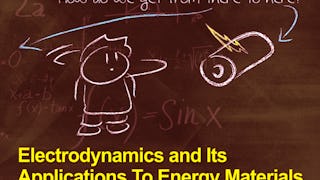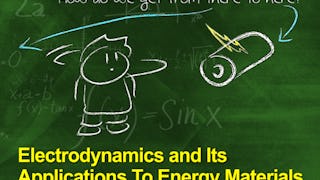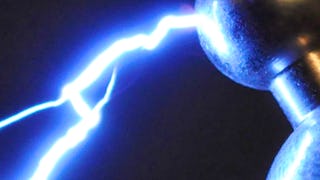This course is a continuation of Electrodynamics: An Introduction. Here, we will cover different methods of calculating an electric field. In addition, we will introduce polarization, dielectrics, and how electric fields create dipoles.


Electrodynamics: Analysis of Electric Fields
This course is part of Electrodynamics Specialization

Instructor: Seungbum Hong
10,385 already enrolled
Included with
(169 reviews)
Skills you'll gain
Details to know

Add to your LinkedIn profile
5 assignments
See how employees at top companies are mastering in-demand skills

Build your subject-matter expertise
- Learn new concepts from industry experts
- Gain a foundational understanding of a subject or tool
- Develop job-relevant skills with hands-on projects
- Earn a shareable career certificate

There are 5 modules in this course
The primary focus of the first portion of this module is the concept of dipole moments, both for a single molecule and an arbitrary distribution. The equations for both the potential and the electric field of a dipole are derived within the first part of the lecture. This lecture also describes the method of images and how it can be applied to solving the electric field from different geometries.
What's included
3 videos2 readings1 assignment
In this module, we cover how to solve for 2D electric fields, and also introduce some basic applications for electrostatics. We describe how imaginary numbers can be used to plot the electric field and equipotential surfaces. Then, we discuss how concepts such as natural resonance, potential distribution, and grid spacing can help design modern devices and experiments.
What's included
2 videos1 reading1 assignment
This module introduces the importance of electrostatic energy and describes how to evaluate it. It also covers how to use the concept of virtual work and how that can be used to find force; specifically we examine this in respect to capacitors. Finally, we discuss where the electrostatic energy can be located.
What's included
2 videos1 reading1 assignment
In the first module concerning dielectrics, we discuss what constitutes a dielectric material and how their presence effects the operation of a capacitor. Then, we cover many ways to characterize a dielectric such as susceptibility and displacement. Finally, we investigate the forces on a dielectric with respect to the capacitor.
What's included
2 videos1 reading1 assignment
This module starts by describing how to obtain polarization for molecules under an electric field. Then, we cover methods to solve for the dielectric constant, such as Clausius-Mossotti Equation and Onsager Equation. Our last topic covered is the concept of ferroelectricity and how ferroelectric materials can be modeled by the Curie-Weiss law and other methods.
What's included
3 videos1 reading1 assignment
Earn a career certificate
Add this credential to your LinkedIn profile, resume, or CV. Share it on social media and in your performance review.
Instructor

Explore more from Electrical Engineering
 Status: Free Trial
Status: Free TrialKorea Advanced Institute of Science and Technology(KAIST)
 Status: Free Trial
Status: Free TrialKorea Advanced Institute of Science and Technology(KAIST)
 Status: Free Trial
Status: Free TrialKorea Advanced Institute of Science and Technology(KAIST)
 Status: Free Trial
Status: Free TrialRice University
Why people choose Coursera for their career




Learner reviews
169 reviews
- 5 stars
83.43%
- 4 stars
11.83%
- 3 stars
3.55%
- 2 stars
0%
- 1 star
1.18%
Showing 3 of 169
Reviewed on Jan 1, 2023
Thank you , this second course of electrodynamics helped me to get a deeper understanding of electrical phenomena..
Reviewed on May 17, 2020
Excellent course offered by Korean advanced of science and technology
Reviewed on Jul 13, 2020
I am a 12th grade student and still I was able to Understand everything The course was beautifully presented

Open new doors with Coursera Plus
Unlimited access to 10,000+ world-class courses, hands-on projects, and job-ready certificate programs - all included in your subscription
Advance your career with an online degree
Earn a degree from world-class universities - 100% online
Join over 3,400 global companies that choose Coursera for Business
Upskill your employees to excel in the digital economy
Frequently asked questions
To access the course materials, assignments and to earn a Certificate, you will need to purchase the Certificate experience when you enroll in a course. You can try a Free Trial instead, or apply for Financial Aid. The course may offer 'Full Course, No Certificate' instead. This option lets you see all course materials, submit required assessments, and get a final grade. This also means that you will not be able to purchase a Certificate experience.
When you enroll in the course, you get access to all of the courses in the Specialization, and you earn a certificate when you complete the work. Your electronic Certificate will be added to your Accomplishments page - from there, you can print your Certificate or add it to your LinkedIn profile.
Yes. In select learning programs, you can apply for financial aid or a scholarship if you can’t afford the enrollment fee. If fin aid or scholarship is available for your learning program selection, you’ll find a link to apply on the description page.
More questions
Financial aid available,

